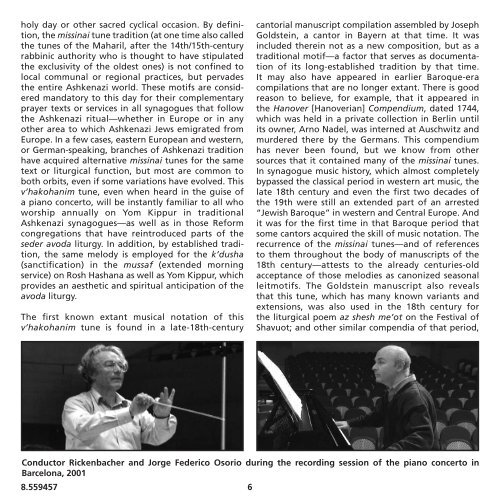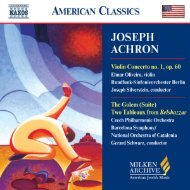holy day or other sacred cyclical occasion. By definition,the missinai tune tradition (at one time also calledthe tunes <strong>of</strong> the Maharil, after the 14th/15th-centuryrabbinic authority who is thought to have stipulatedthe exclusivity <strong>of</strong> the oldest ones) is not confined tolocal communal or regional practices, but pervadesthe entire Ashkenazi world. These motifs are consideredmandatory to this day for their complementaryprayer texts or services in all synagogues that followthe Ashkenazi ritual—whether in Europe or in anyother area to which Ashkenazi Jews emigrated fromEurope. In a few cases, eastern European and western,or German-speaking, branches <strong>of</strong> Ashkenazi traditionhave acquired alternative missinai tunes for the sametext or liturgical function, but most are common toboth orbits, even if some variations have evolved. Thisv’hakohanim tune, even when heard in the guise <strong>of</strong>a piano concerto, will be instantly familiar to all whoworship annually on Yom Kippur in traditionalAshkenazi synagogues—as well as in those Reformcongregations that have reintroduced parts <strong>of</strong> theseder avoda liturgy. In addition, by established tradition,the same melody is employed for the k’dusha(sanctification) in the mussaf (extended morningservice) on Rosh Hashana as well as Yom Kippur, whichprovides an aesthetic and spiritual anticipation <strong>of</strong> theavoda liturgy.The first known extant musical notation <strong>of</strong> thisv’hakohanim tune is found in a late-18th-centurycantorial manuscript compilation assembled by JosephGoldstein, a cantor in Bayern at that time. It wasincluded therein not as a new composition, but as atraditional motif—a factor that serves as documentation<strong>of</strong> its long-established tradition by that time.It may also have appeared in earlier Baroque-eracompilations that are no longer extant. There is goodreason to believe, for example, that it appeared inthe Hanover [Hanoverian] Compendium, dated 1744,which was held in a private collection in Berlin untilits owner, Arno Nadel, was interned at Auschwitz andmurdered there by the Germans. This compendiumhas never been found, but we know from othersources that it contained many <strong>of</strong> the missinai tunes.In synagogue music history, which almost completelybypassed the classical period in western art music, thelate 18th century and even the first two decades <strong>of</strong>the 19th were still an extended part <strong>of</strong> an arrested“<strong>Jewish</strong> Baroque” in western and Central Europe. Andit was for the first time in that Baroque period thatsome cantors acquired the skill <strong>of</strong> music notation. Therecurrence <strong>of</strong> the missinai tunes—and <strong>of</strong> referencesto them throughout the body <strong>of</strong> manuscripts <strong>of</strong> the18th century—attests to the already centuries-oldacceptance <strong>of</strong> those melodies as canonized seasonalleitmotifs. The Goldstein manuscript also revealsthat this tune, which has many known variants andextensions, was also used in the 18th century forthe liturgical poem az shesh me’ot on the Festival <strong>of</strong>Shavuot; and other similar compendia <strong>of</strong> that period,Conductor Rickenbacher and Jorge Federico Osorio during the recording session <strong>of</strong> the piano concerto inBarcelona, 20018.559457 6
such as one by Ahron Beer (1738–1821), a cantor atvarious times in Bamberg, Paderborn, and Berlin,indicate its use in an entry dated 1782 for another text<strong>of</strong> the avoda service, v’khakh haya omer.Apart from its theological and emotional link to theTemple era, to <strong>Jewish</strong> antiquity, to the sacred historicalparameters <strong>of</strong> ancient Jerusalem, and even to whatsome perceive as a form <strong>of</strong> communication with God(the sacrificial system) that ended with the destruction<strong>of</strong> the Second Temple, the inclusion <strong>of</strong> the seder avodain the Yom Kippur liturgy is widely interpreted as anexpression <strong>of</strong> the <strong>Jewish</strong> people’s yearning both forspiritual liberation and redemption and for nationalrestoration—albeit on religious terms.The first thirty-six measures <strong>of</strong> the opening movement,marked “Maestoso,” are devoted to the introductionand modest development <strong>of</strong> the biblical cantillationelement. Allusions to pentatonic modality in some<strong>of</strong> the harmonic treatment contribute to a flavor <strong>of</strong>antiquity as much as to a sense <strong>of</strong> timelessness. Amutation <strong>of</strong> that motive, achieved primarily by itsdotted rhythmic alteration—which gives it an entirelydifferent, joyful character—acts as a contrastingsecond subject (a’, if we consider the cantillationmotive as “a” and the v’hakohanim tune as “b”).The v’hakohanim tune, set up by a harbinger <strong>of</strong> itsrhythmic incipit (intervalically altered), begins inearnest at measure 76. There, following an inventivemodulation to E major/C-sharp minor, one hears itsemblematic and identifying upward-moving sequence<strong>of</strong> triplets—introduced in a solo piano passage withquiet authority (Lento). Those triplets (which, in someother traditional variants, can comprise unequal notevalues) seem in this artistic context inherently to invitedevelopment through extended pianistic displays<strong>of</strong> motoric octave passagework; and the composerexploits that invitation to its fullest throughout themovement. Punctuated by ornately arpeggiated,cadenza-like solo passages, the three themes alternateand become intertwined until they fade away at theconclusion <strong>of</strong> the movement with a final echoed referenceto the cantillation motive.The brief second movement is based almost entirely onthe tune <strong>of</strong> Artza alinu, one <strong>of</strong> the most familiar andenduring Zionist-oriented songs associated with thealutzim—the pioneer settlers in Palestine during thedecades prior to statehood. In a succession <strong>of</strong> severaldistinct waves <strong>of</strong> immigration (aliyot; sing., aliya) fromEurope beginning in the 1880s, they came to reclaim,rebuild, reestablish, and take up permanent residencyin the ancient Land <strong>of</strong> Israel as the reborn <strong>Jewish</strong>national homeland. As a historical principle <strong>of</strong> Zionism,however, aliya implies more than simple immigration.It signifies the primary mode <strong>of</strong> commitment to therealization <strong>of</strong> the Zionist ideal—for which Weinbergand most <strong>of</strong> his colleagues in the <strong>Jewish</strong> national artmusic movement had a solid affinity that derived fromthe concept <strong>of</strong> modern cultural rejuvenation. The termaliya translates literally as “elevation” or “ascending,”connoting—even in biblical literature—an ascentrather than merely a relocation or a return. In modernZionist ideology it refers to such immigration to theLand <strong>of</strong> Israel (whether in its pre- or post-state phase)as a form <strong>of</strong> hands-on participation in <strong>Jewish</strong> nationalrebirth. The alutzim could, therefore, be consideredto be elevating themselves to the assumption <strong>of</strong> adirect role in the reconnection to <strong>Jewish</strong> political antiquityand in the embryonic stage <strong>of</strong> development <strong>of</strong> themodern <strong>Jewish</strong> polity.Beginning with the First Aliya (1882–1903), which wasnot yet even wedded indelibly to political Zionism,and extending through three successive waves <strong>of</strong> aliya(1904–14; 1919–23; and 1924–28), the olim (immigrants)were propelled naturally toward fashioning and singingsecular Hebrew songs that reflected the ideals <strong>of</strong> their“new” modern <strong>Jewish</strong> identity, their new social andcultural values, and their commitment to rebuildingthe land—agriculturally as well as spiritually. Thisaggregate Hebrew song repertoire, which enjoyed itsripest maturation and evolved to its fullest beginningwith the Third and Fourth Aliyot, comprises modernHebrew adaptations <strong>of</strong> transplanted European(Russian, Ukrainian, and Polish, as well as Yiddish)folksong, Hassidic melodies, formerly liturgical tunes,and even Russian operatic excerpts; indigenous Arabic,7 8.559457
















